|
Home Page
Glen Echo
The Town
Chautauqua
Amusement Park
• Post Cards
• Souvenirs
• Tickets
• Early Programs
Modern Times
History Book
Cabin John
The Town
The Hotel
Amusement Park
The Bridge
Legends
History Book
Great Falls
Post Cards
Other Stuff
Conduit Road
The Trolleys
Buildings
The Aqueduct
The Road
General
Capital Transit Passes
Historic item Trader
Minnie Brooke Postcards
|
Conduit Road - The Road
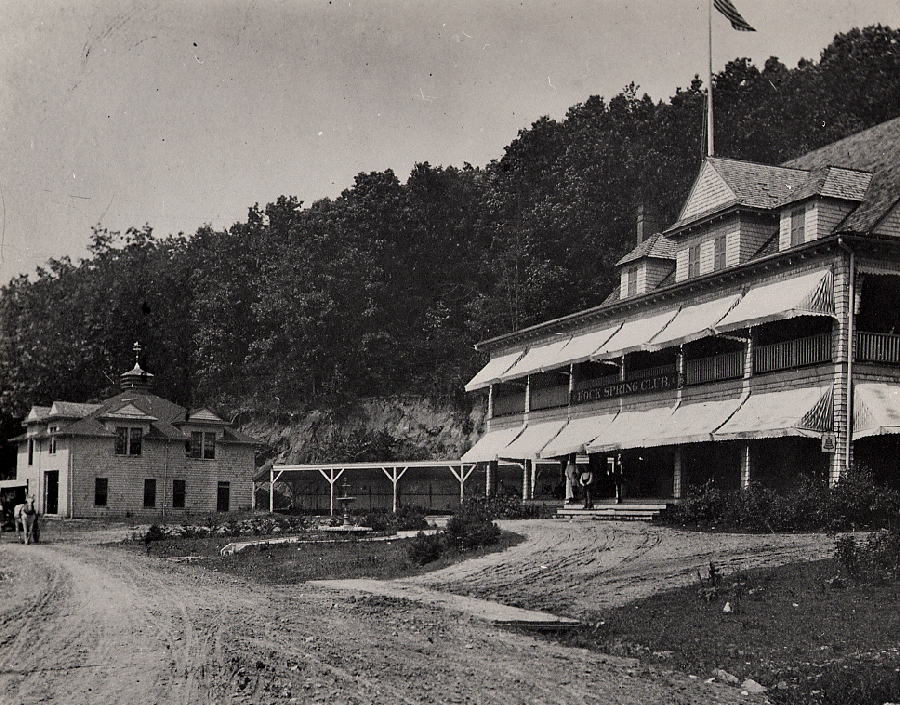
The Rock Spring Club, a private club that offered alcoholic beverages in spite of Montgomery County being 'DRY' at the time
The Conduit Road
In its earliest form Conduit Road was paved with crushed stone, tightly compacted. The road surface was built with horse drawn carriages in mind, thus the surface had to accomodate horse hooves and narrow iron banded carriage wheels. Carriage wheels tended to cut ruts int he road surface over time, so continual maintainence was needed.
The packed stone surface can be seen in front of the Rock Spring Club building which stood between Brookmont and Glen Echo Heights in the phot to the right.
The Army Corp of Engineers was responsible for maintaining the road, but much of the work was sub-contracted to private firms. The 'Conduit' itself was maintained by the Corp.
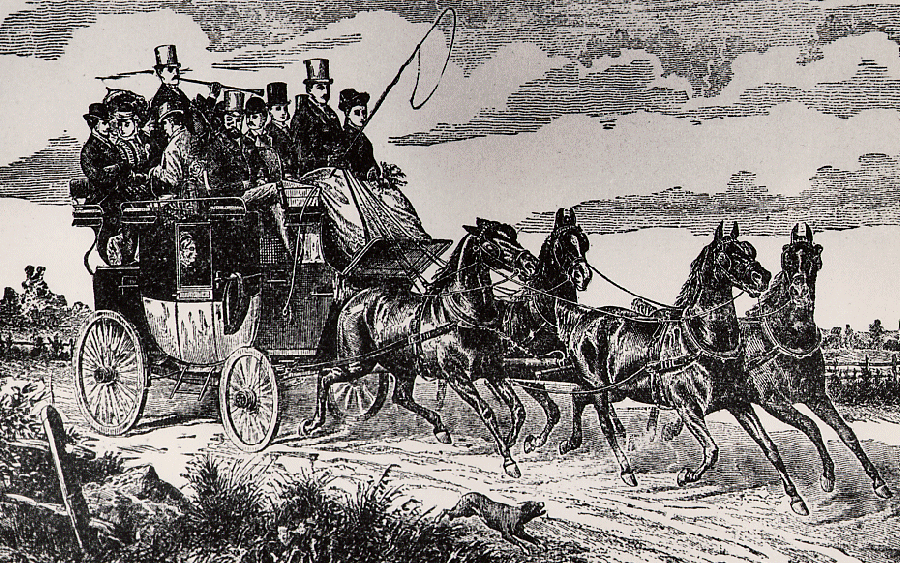
A Tally-Ho Coach, ca 1897
The Conduit Road
Initially the Corp of Engineers resisted public use of the road, saying it was intended only as a maintainence road and not a public highway, but the public ignored their statements.
The beautiful scenery along the road made it a favorite country outing destination, after all, it lead to the Cabin John Bridge, then one of the mechanical wonders of the world.
Some came by private carriage to see the bridge but others came by the equivalent of a modern day tour bus, a Tally-Ho Coach.
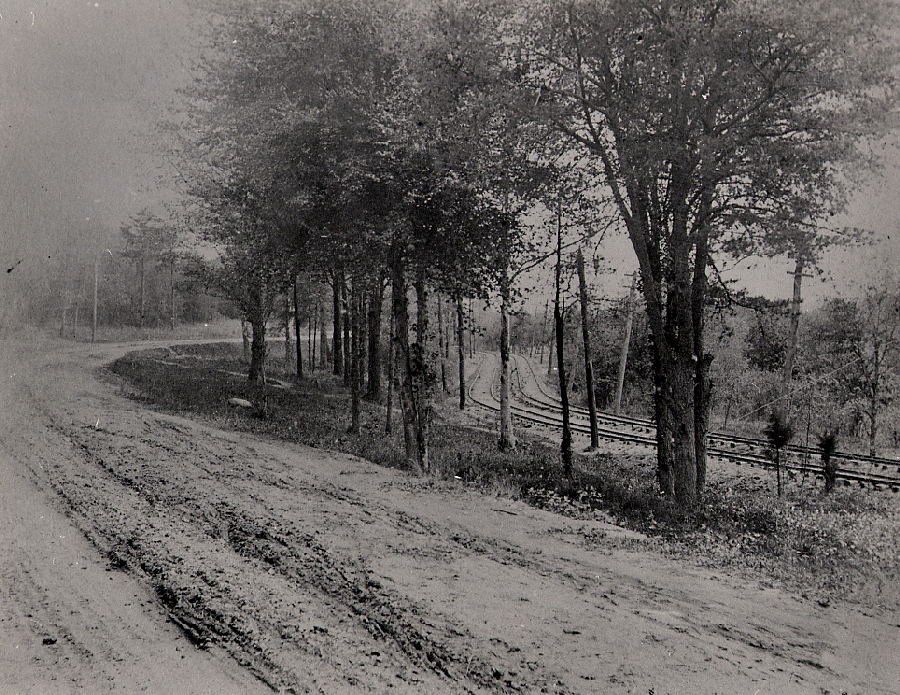
Trolley tracks along the Conduit Road, ca. 1899
The Conduit Road
In 1896 a trolley line was built paralleling the Conduit Road from Georgetown in the District of Columbia to the Cabin John Bridge. Initial plans had the line continuing across the Cabin John Creek all the way to Great Falls, but the Cabin John ravine was never crossed by the trolley line.
The ride was especially pleasant in the summer when open sided cars were run. Riding the trolley let the whole family watch the scenery. After the opening of Glen Echo as an amusement park, ridership on the trolley line increased, especially on weekends. The trolley line ran along Conduit Road until the line was finally closed in 1961.
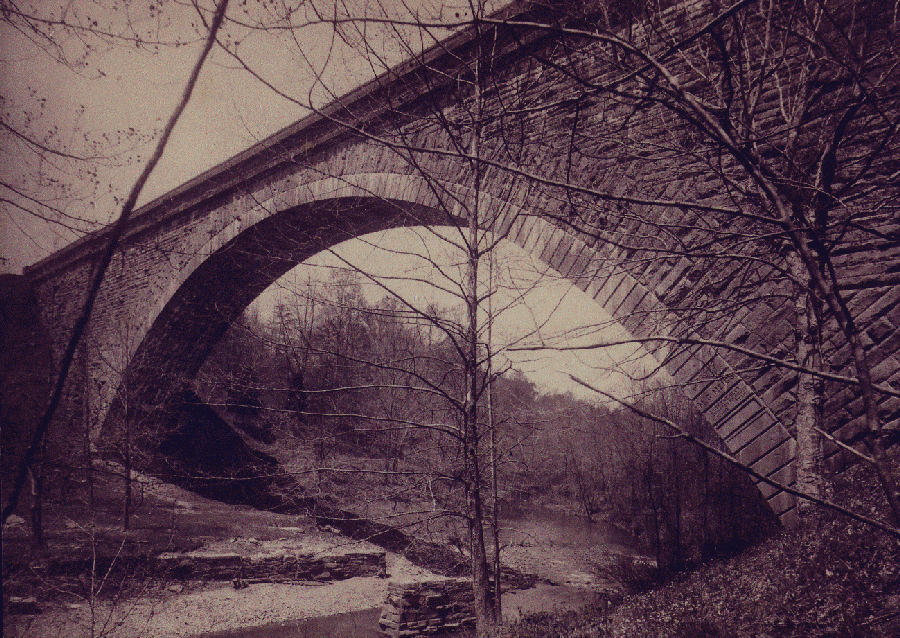
The Cabin John Bridge, route of the Conduit Road
The Conduit Road
The road crossed Cabin John Creek on the famous Cabin John Bridge. The bridge was the longest single-span stone arch in the world from the time of its construction in the 1850s-60s until 1909 when a longer span was built in Europe.
When first built the bridge had no railings, only railroad ties staked into the road surface along the edges of the bridge. Many horses, not to mention many drivers, found the unprotected sides unnerving, and in 1872 red-sandstone parapets were added to the edges of the bridge further narrowing the road across the span.
The selection of Seneca Sandstone for the parapets would cause considerable problems in later decades.
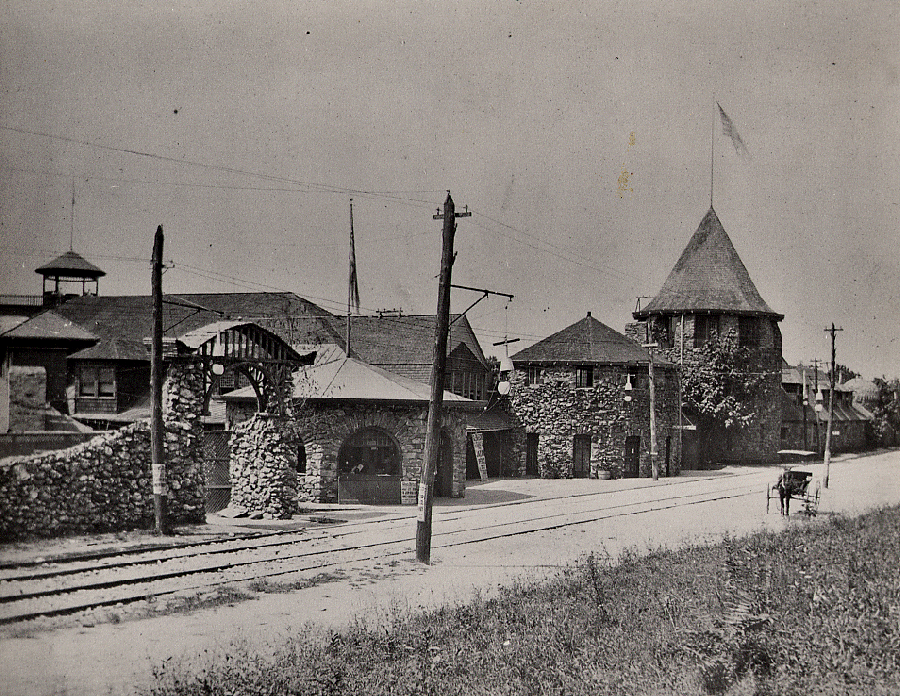
The entrance to Glen Echo Park, ca 1899
The Conduit Road
The completion of the trolley line from Georgetown brought about a period of reduced carriage traffic on the Conduit Road. The trolley ride was cheap and pleasant, so many visitors to Glen Echo Park came that way. From 1896 until around 1901 visitors could also ride to Glen Echo from Chevy Chase Circle on the Washington & Glen Echo Electric line.
The photo to the right shows the trolley tracks in front of Glen Echo Park, with a single carriage on the access road which split off from Conduit Road. To take this photo, the photographer was positioned on or right next to Conduit Road. Glen Echo Park's entrance was little different from the Glen Echo Chautauqua entrance of earlier in the decade.
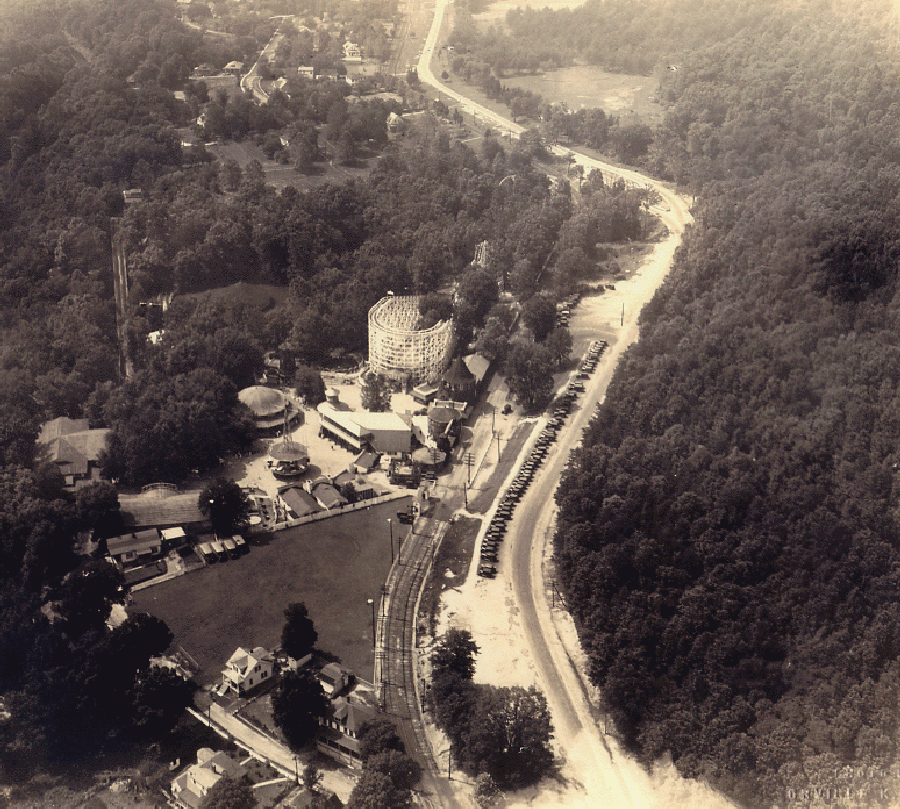
Automobiles in the parking lot at Glen Echo Amusement Park. ca. 1920s
The Conduit Road
By the 1920's there was greater availability of automobiles to the general public. The Conduit Road again was a favorite ride. The inflated rubber tires of the cars made for a smoother and quieter ride along the road, but they created some additional problems.
Carriages were slow moving, and though they stired uo dust, they did relatively little damage to the road as compared to thier new replacements. The Corp of Engineers responded in two ways; first setting a very slow 12 mile per hour speed limit ont he road, and second, changing the paving method to a tar covered packed gravel surface.
The earliest tar surface was sub-contracted to the TarVia Company. TarVia used photos of this prestiegeous job in advertisements for their services for a number of years.

Glen Echo Town Marshall Collins ticketing a speeding car on his bicycle. 1907
The Conduit Road
The 12 mile per hour speed limit generated an unexpected side effect. The town Marshall of Glen Echo decided that issuing tickets to speeding drivers on Conduit Road would be a good way to enforce law and order. However, the road was Federal property and thus not under the jursidiction of a town marshall, but this in no way slowed Marshall Collins down.
The local newspapers were filled for months in 1907 with tales of the young Marshall stopping sppeders on his bicycle and issuing them tickets, some with a $25 fine (this when the average worker earned $15-$20 per week).
Things came to a head when Collins ticketed an Ambassador and then shortly later ticketed a car containing the President, who was on his way to dinner at the Cabin John Hotel.
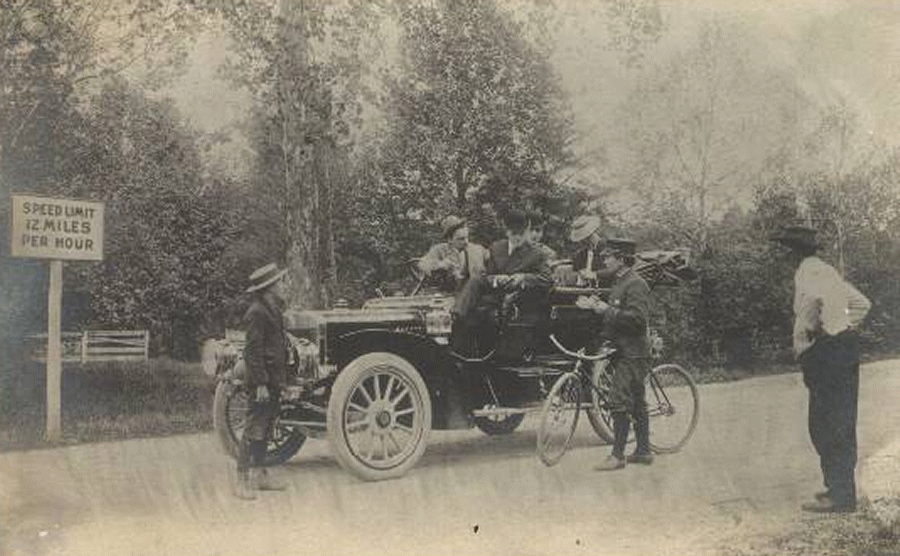
A suffrage march along Conduit Road from Great Falls to Washington City, 1914
The Conduit Road
Conduit Road has been used for many things over the years, one of the most unusual was a march held in 1914 for women's suffrage. This was one small leg of a series of marches all over the country for that cause.
This group of marchers was photographed coming from Great Falls along Conduit Road, approaching the Seven Locks area which was then the center of life in Cabin John.
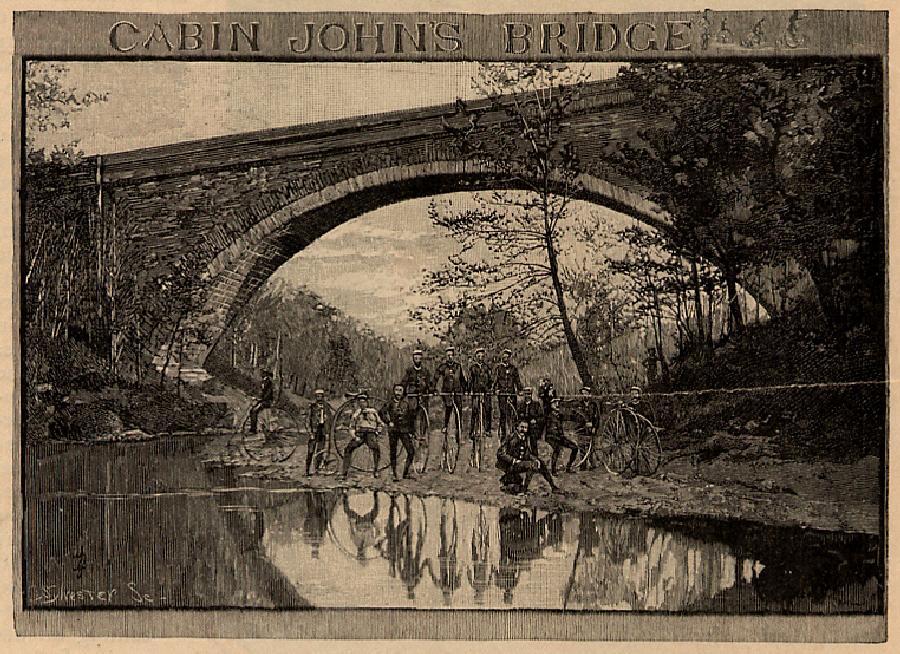
A group of cuclists under the Cabin John Bridge, 1885
The Conduit Road
Conduit Road was a favorite of bicyclists as early as 1885, the Washington newspapers regularly had notices of bike clubs scheduling trips along the road. The cyclists would often eat at the Cabin John Hotel before returning to the city.
Edwin Baltzley, being a savy businessman, knew a good thing early on in the bicycle craze and banded together with two other men and opened a bicycle manufacturing business in Georgetown The business did well for a few years, then diappeared.
Conduit Road remained a favorite bicycle ride for many years. In recent decades, a bike trail has been added paralleling much of the road.
|
|




